Shuang Wang
Generalization-aware Remote Sensing Change Detection via Domain-agnostic Learning
Apr 01, 2025Abstract:Change detection has essential significance for the region's development, in which pseudo-changes between bitemporal images induced by imaging environmental factors are key challenges. Existing transformation-based methods regard pseudo-changes as a kind of style shift and alleviate it by transforming bitemporal images into the same style using generative adversarial networks (GANs). However, their efforts are limited by two drawbacks: 1) Transformed images suffer from distortion that reduces feature discrimination. 2) Alignment hampers the model from learning domain-agnostic representations that degrades performance on scenes with domain shifts from the training data. Therefore, oriented from pseudo-changes caused by style differences, we present a generalizable domain-agnostic difference learning network (DonaNet). For the drawback 1), we argue for local-level statistics as style proxies to assist against domain shifts. For the drawback 2), DonaNet learns domain-agnostic representations by removing domain-specific style of encoded features and highlighting the class characteristics of objects. In the removal, we propose a domain difference removal module to reduce feature variance while preserving discriminative properties and propose its enhanced version to provide possibilities for eliminating more style by decorrelating the correlation between features. In the highlighting, we propose a cross-temporal generalization learning strategy to imitate latent domain shifts, thus enabling the model to extract feature representations more robust to shifts actively. Extensive experiments conducted on three public datasets demonstrate that DonaNet outperforms existing state-of-the-art methods with a smaller model size and is more robust to domain shift.
DREMnet: An Interpretable Denoising Framework for Semi-Airborne Transient Electromagnetic Signal
Mar 28, 2025Abstract:The semi-airborne transient electromagnetic method (SATEM) is capable of conducting rapid surveys over large-scale and hard-to-reach areas. However, the acquired signals are often contaminated by complex noise, which can compromise the accuracy of subsequent inversion interpretations. Traditional denoising techniques primarily rely on parameter selection strategies, which are insufficient for processing field data in noisy environments. With the advent of deep learning, various neural networks have been employed for SATEM signal denoising. However, existing deep learning methods typically use single-mapping learning approaches that struggle to effectively separate signal from noise. These methods capture only partial information and lack interpretability. To overcome these limitations, we propose an interpretable decoupled representation learning framework, termed DREMnet, that disentangles data into content and context factors, enabling robust and interpretable denoising in complex conditions. To address the limitations of CNN and Transformer architectures, we utilize the RWKV architecture for data processing and introduce the Contextual-WKV mechanism, which allows unidirectional WKV to perform bidirectional signal modeling. Our proposed Covering Embedding technique retains the strong local perception of convolutional networks through stacked embedding. Experimental results on test datasets demonstrate that the DREMnet method outperforms existing techniques, with processed field data that more accurately reflects the theoretical signal, offering improved identification of subsurface electrical structures.
Interpretable Deep Learning Paradigm for Airborne Transient Electromagnetic Inversion
Mar 28, 2025Abstract:The extraction of geoelectric structural information from airborne transient electromagnetic(ATEM)data primarily involves data processing and inversion. Conventional methods rely on empirical parameter selection, making it difficult to process complex field data with high noise levels. Additionally, inversion computations are time consuming and often suffer from multiple local minima. Existing deep learning-based approaches separate the data processing steps, where independently trained denoising networks struggle to ensure the reliability of subsequent inversions. Moreover, end to end networks lack interpretability. To address these issues, we propose a unified and interpretable deep learning inversion paradigm based on disentangled representation learning. The network explicitly decomposes noisy data into noise and signal factors, completing the entire data processing workflow based on the signal factors while incorporating physical information for guidance. This approach enhances the network's reliability and interpretability. The inversion results on field data demonstrate that our method can directly use noisy data to accurately reconstruct the subsurface electrical structure. Furthermore, it effectively processes data severely affected by environmental noise, which traditional methods struggle with, yielding improved lateral structural resolution.
ChangeDiff: A Multi-Temporal Change Detection Data Generator with Flexible Text Prompts via Diffusion Model
Dec 20, 2024



Abstract:Data-driven deep learning models have enabled tremendous progress in change detection (CD) with the support of pixel-level annotations. However, collecting diverse data and manually annotating them is costly, laborious, and knowledge-intensive. Existing generative methods for CD data synthesis show competitive potential in addressing this issue but still face the following limitations: 1) difficulty in flexibly controlling change events, 2) dependence on additional data to train the data generators, 3) focus on specific change detection tasks. To this end, this paper focuses on the semantic CD (SCD) task and develops a multi-temporal SCD data generator ChangeDiff by exploring powerful diffusion models. ChangeDiff innovatively generates change data in two steps: first, it uses text prompts and a text-to-layout (T2L) model to create continuous layouts, and then it employs layout-to-image (L2I) to convert these layouts into images. Specifically, we propose multi-class distribution-guided text prompts (MCDG-TP), allowing for layouts to be generated flexibly through controllable classes and their corresponding ratios. Subsequently, to generalize the T2L model to the proposed MCDG-TP, a class distribution refinement loss is further designed as training supervision. %For the former, a multi-classdistribution-guided text prompt (MCDG-TP) is proposed to complement via controllable classes and ratios. To generalize the text-to-image diffusion model to the proposed MCDG-TP, a class distribution refinement loss is designed as training supervision. For the latter, MCDG-TP in three modes is proposed to synthesize new layout masks from various texts. Our generated data shows significant progress in temporal continuity, spatial diversity, and quality realism, empowering change detectors with accuracy and transferability. The code is available at https://github.com/DZhaoXd/ChangeDiff
SiamSeg: Self-Training with Contrastive Learning for Unsupervised Domain Adaptation in Remote Sensing
Oct 17, 2024



Abstract:Semantic segmentation of remote sensing (RS) images is a challenging task with significant potential across various applications. Deep learning, especially supervised learning with large-scale labeled datasets, has greatly advanced this field. However, acquiring high-quality labeled data is expensive and time-consuming. Moreover, variations in ground sampling distance (GSD), imaging equipment, and geographic diversity contribute to domain shifts between datasets, which pose significant challenges to models trained solely on source domain data, leading to poor cross-domain performance. Domain shift is well-known for undermining a model's generalization ability in the target domain. To address this, unsupervised domain adaptation (UDA) has emerged as a promising solution, enabling models to learn from unlabeled target domain data while training on labeled source domain data. Recent advancements, particularly in self-supervised learning via pseudo-label generation, have shown potential in mitigating domain discrepancies. Strategies combining source and target domain images with their true and pseudo labels for self-supervised training have been effective in addressing domain bias. Despite progress in computer vision, the application of pseudo-labeling methods to RS image segmentation remains underexplored.
3-D Magnetotelluric Deep Learning Inversion Guided by Pseudo-Physical Information
Oct 12, 2024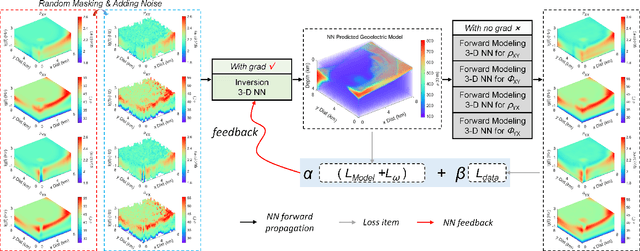
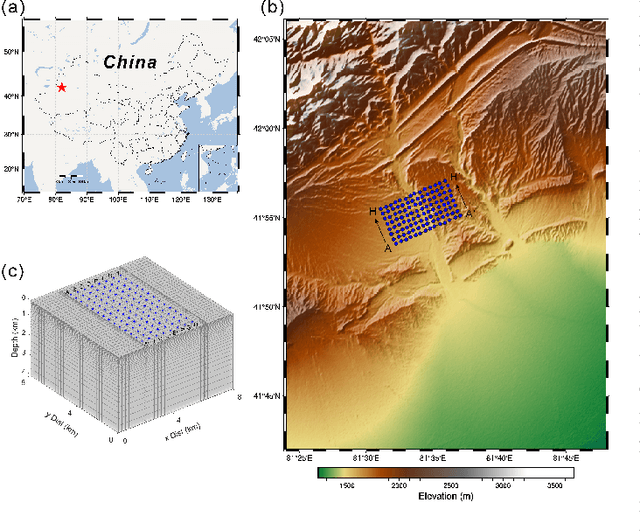
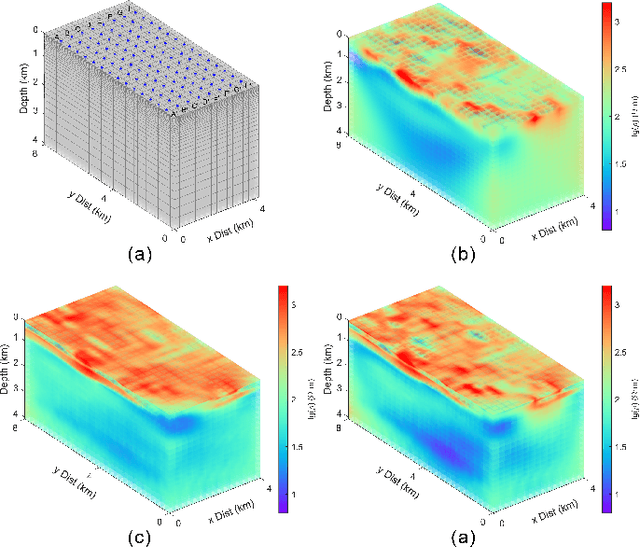
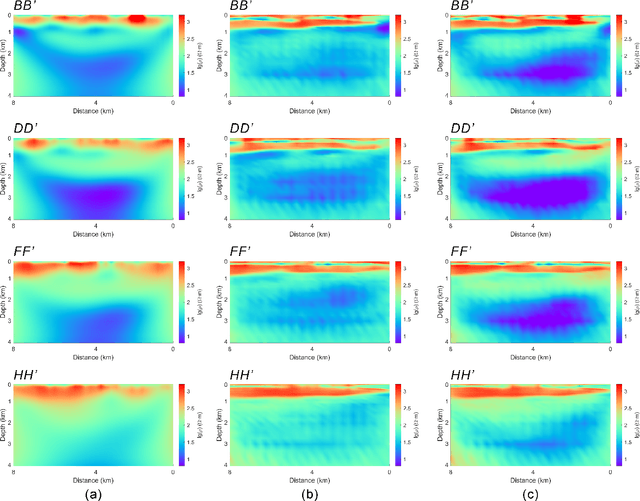
Abstract:Magnetotelluric deep learning (DL) inversion methods based on joint data-driven and physics-driven have become a hot topic in recent years. When mapping observation data (or forward modeling data) to the resistivity model using neural networks (NNs), incorporating the error (loss) term of the inversion resistivity's forward modeling response--which introduces physical information about electromagnetic field propagation--can significantly enhance the inversion accuracy. To efficiently achieve data-physical dual-driven MT deep learning inversion for large-scale 3-D MT data, we propose using DL forward modeling networks to compute this portion of the loss. This approach introduces pseudo-physical information through the forward modeling of NN simulation, further guiding the inversion network fitting. Specifically, we first pre-train the forward modeling networks as fixed forward modeling operators, then transfer and integrate them into the inversion network training, and finally optimize the inversion network by minimizing the multinomial loss. Theoretical experimental results indicate that despite some simulation errors in DL forward modeling, the introduced pseudo-physical information still enhances inversion accuracy and significantly mitigates the overfitting problem during training. Additionally, we propose a new input mode that involves masking and adding noise to the data, simulating the field data environment of 3-D MT inversion, thereby making the method more flexible and effective for practical applications.
Applying the Lower-Biased Teacher Model in Semi-Suepervised Object Detection
Sep 29, 2024Abstract:I present the Lower Biased Teacher model, an enhancement of the Unbiased Teacher model, specifically tailored for semi-supervised object detection tasks. The primary innovation of this model is the integration of a localization loss into the teacher model, which significantly improves the accuracy of pseudo-label generation. By addressing key issues such as class imbalance and the precision of bounding boxes, the Lower Biased Teacher model demonstrates superior performance in object detection tasks. Extensive experiments on multiple semi-supervised object detection datasets show that the Lower Biased Teacher model not only reduces the pseudo-labeling bias caused by class imbalances but also mitigates errors arising from incorrect bounding boxes. As a result, the model achieves higher mAP scores and more reliable detection outcomes compared to existing methods. This research underscores the importance of accurate pseudo-label generation and provides a robust framework for future advancements in semi-supervised learning for object detection.
RepAct: The Re-parameterizable Adaptive Activation Function
Jun 28, 2024



Abstract:Addressing the imperative need for efficient artificial intelligence in IoT and edge computing, this study presents RepAct, a re-parameterizable adaptive activation function tailored for optimizing lightweight neural networks within the computational limitations of edge devices. By employing a multi-branch structure with learnable adaptive weights, RepAct enriches feature processing and enhances cross-layer interpretability. When evaluated on tasks such as image classification and object detection, RepAct notably surpassed conventional activation functions in lightweight networks, delivering up to a 7.92% accuracy boost on MobileNetV3-Small for the ImageNet100 dataset, while maintaining computational complexity on par with HardSwish. This innovative approach not only maximizes model parameter efficiency but also significantly improves the performance and understanding capabilities of lightweight neural networks, demonstrating its potential for real-time edge computing applications.
Stable Neighbor Denoising for Source-free Domain Adaptive Segmentation
Jun 10, 2024
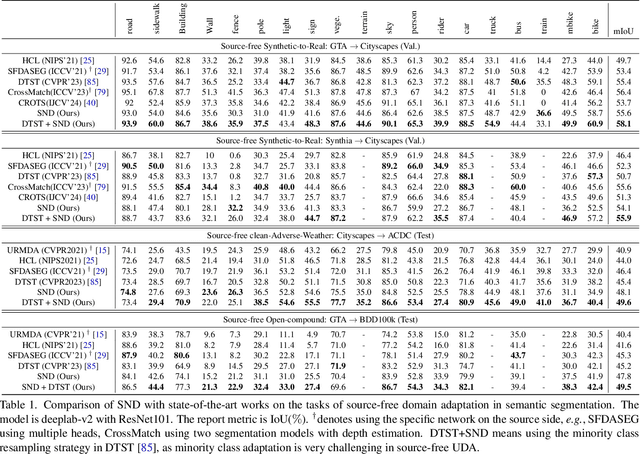
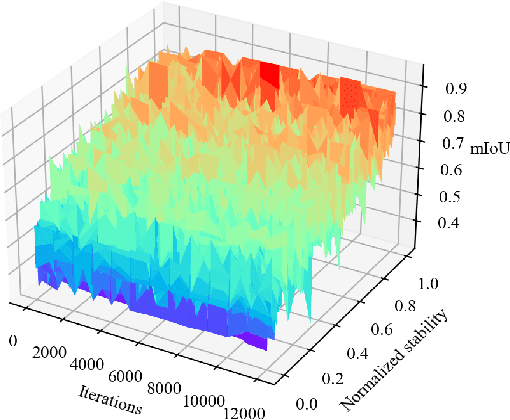
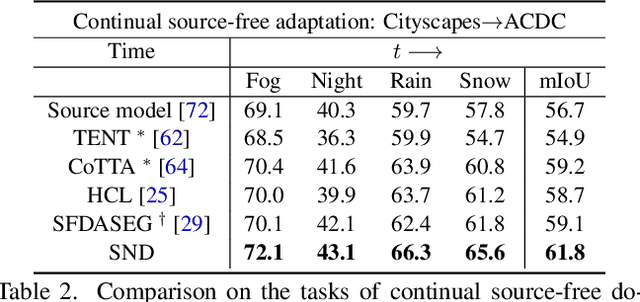
Abstract:We study source-free unsupervised domain adaptation (SFUDA) for semantic segmentation, which aims to adapt a source-trained model to the target domain without accessing the source data. Many works have been proposed to address this challenging problem, among which uncertainty-based self-training is a predominant approach. However, without comprehensive denoising mechanisms, they still largely fall into biased estimates when dealing with different domains and confirmation bias. In this paper, we observe that pseudo-label noise is mainly contained in unstable samples in which the predictions of most pixels undergo significant variations during self-training. Inspired by this, we propose a novel mechanism to denoise unstable samples with stable ones. Specifically, we introduce the Stable Neighbor Denoising (SND) approach, which effectively discovers highly correlated stable and unstable samples by nearest neighbor retrieval and guides the reliable optimization of unstable samples by bi-level learning. Moreover, we compensate for the stable set by object-level object paste, which can further eliminate the bias caused by less learned classes. Our SND enjoys two advantages. First, SND does not require a specific segmentor structure, endowing its universality. Second, SND simultaneously addresses the issues of class, domain, and confirmation biases during adaptation, ensuring its effectiveness. Extensive experiments show that SND consistently outperforms state-of-the-art methods in various SFUDA semantic segmentation settings. In addition, SND can be easily integrated with other approaches, obtaining further improvements.
* 2024 Conference on Computer Vision and Pattern Recognition
Transcending Fusion: A Multi-Scale Alignment Method for Remote Sensing Image-Text Retrieval
May 29, 2024Abstract:Remote Sensing Image-Text Retrieval (RSITR) is pivotal for knowledge services and data mining in the remote sensing (RS) domain. Considering the multi-scale representations in image content and text vocabulary can enable the models to learn richer representations and enhance retrieval. Current multi-scale RSITR approaches typically align multi-scale fused image features with text features, but overlook aligning image-text pairs at distinct scales separately. This oversight restricts their ability to learn joint representations suitable for effective retrieval. We introduce a novel Multi-Scale Alignment (MSA) method to overcome this limitation. Our method comprises three key innovations: (1) Multi-scale Cross-Modal Alignment Transformer (MSCMAT), which computes cross-attention between single-scale image features and localized text features, integrating global textual context to derive a matching score matrix within a mini-batch, (2) a multi-scale cross-modal semantic alignment loss that enforces semantic alignment across scales, and (3) a cross-scale multi-modal semantic consistency loss that uses the matching matrix from the largest scale to guide alignment at smaller scales. We evaluated our method across multiple datasets, demonstrating its efficacy with various visual backbones and establishing its superiority over existing state-of-the-art methods. The GitHub URL for our project is: https://github.com/yr666666/MSA
 Add to Chrome
Add to Chrome Add to Firefox
Add to Firefox Add to Edge
Add to Edge